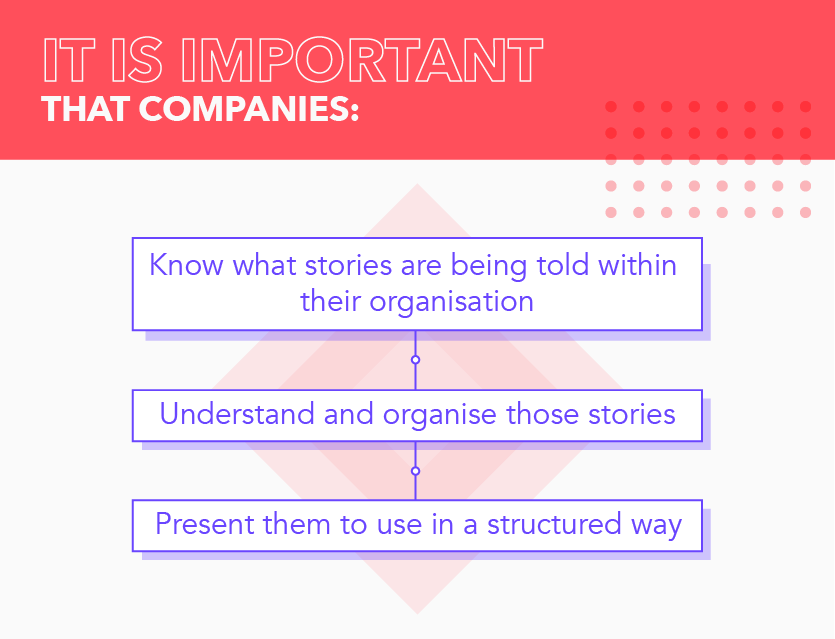

How we mined stories for a multinational corporation’s content hub
Stories are what make us human, and they’re also more important for brands than you might think.

Recently we had the opportunity to interview about 50 senior executives of a major global brand to figure out what stories lay hidden within the team.
Part oral history and part corporate journalism, we called it “storymining” and the goal was to build a content calendar for the upcoming year.
Why finding stories is so important
The Japanese novelist Haruki Murakami wrote ‘civilisation is communication … that which is not expressed does not exist’. Stories are the lifeblood of any community and a company is no different. Some tales become part of the official story, some circulate in the background. We are, in many ways, the stories we tell.
But very few companies go to the effort to understand the stories that are in circulation around their water coolers and pantries — or these days on WhatsApp chat groups.
Not only did we uncover some interesting stories for the comms and marketing team to tell — enough to fill out months in the content calendar — we had another unexpected result in that the comms and marketing department of our client realised they now held a valuable commodity within the organisation – their stories.

A company’s stories matter more than you think
Stories help define a company’s public presence, brand and mission. But they also help sell your products or services, generating revenue in the process, and somewhat unexpectedly, they’re a critical part of training and internal communications.
Why? Because they are memorable.
The Velcro theory of memory
In their seminal 2007 book Made to Stick: Why Some Ideas Survive and Others Die (I’d really recommend everyone in the business of communicating get a copy of this book), Chip and Dan Heath talk about the Velcro theory of memory. Basically, the more little hooks you can put into your ideas the better they will stick.
Stories are good hooks for ideas. Jonah Berger, the Wharton marketing professor who wrote the unfortunately titled Contagious (which could be considered a sequel to Made to Stick) said stories are a brand’s Trojan Horse.
They are how you inject (sorry, another medical metaphor) your message into someone’s mind without them realising. Sounds a bit Facebook creepy, but as communicators and writers, we are in the business of promoting our ideas and messages.
Talking shop
The Heaths talk about how storytelling is at the heart of informal learning in a corporate or professional setting. From medical teams in hospitals to photocopy repair crews, swapping stories about troubleshooting problems helps learning and can even save lives.
It’s called talking shop. Salespeople do it when selling. Executives do it when discussing management.
Stories are like flight simulators for the brain.
The brothers Heath
It’s not just memory. The stories we tell frame the way we are perceived. In the case of competing stories being told, it’s important that the story you want told has primacy.
Tesla: A study of corporate narratives
Consider the most storied brand of the moment: Tesla. At an investment level it enjoys such a wonderful valuation – against most fundamentals – because it tells the story of a carbon-free future. If you think of other stories around Tesla, it is Elon Musk, his vision and hard work. And the company’s current success is in part due to the dominance of the positive stories and less focus on the negative stories.
Google Tesla stories and ’Tesla horror stories’ quick comes up with articles quoting ex-employees complaining about unrealistic targets, being overworked, and generally an uncaring approach by the company.
At the moment the positive story is winning and it is paying its way with huge returns to shareholders.
Finding your stories
As a journalist, I know from experience if you talk to anyone long enough you will find a story that’s worthy of writing up.
In our recent storymining exercise, we took this theory to the executive suite and spent a good hour or more with each of the 50 execs at a big client of ours.
The process itself is fairly straight forward. One of our team of journalists would conduct a free-flowing interview with each person about their background, how they came to work at the company, what their job was and what was interesting about it.
We asked lots of common questions to elicit stories, asking about interesting colleagues, challenges they’d encountered recently, interesting customer stories they could relate.
Some of the execs were a bit nervous about being interviewed, but we assured them this was for research and not for public consumption. Should the interview reveal interesting leads there’d be subsequent follow up to get quotes and develop the story.
The free-ranging nature of the interviews and the confidentiality assured meant that often the most interesting stories and anecdotes were revealed at the end of each interview, even after we thought it had officially ended and voice recorder was turned off. It is only when people really relax that they often share the most interesting things.
What we found
We thought, we’d build a database of stories that would inform a year-long content calendar. Obvious stuff.
But the unexpected outcome was that our client’s department, the comms and marketing team, suddenly had this wealth of knowledge about their company’s stories.
We identified stories that existed across different business functions and the people associated with that particular story. Should we wish to create a blog post or video of some of these, everyone needed for the story is listed out and their part of it has been captured.
Suddenly, when requests to our client’s department came from different business segments they were able to respond with stories at hand. Rich stories where they knew the people involved, those who could tell them, the geographies and departments as well.
To the other departments this seemed like miracle working. Comms and marketing suddenly become the keeper of the organisation’s lore. They were in effect ‘bard’ and librarian for this massive global corporation.
We also discovered, across the different business segments, similar stories being shared. There was a common narrative across the organisation, one not immediately obvious to people within the business. It took someone from outside the structure to find these common themes.
Stories make meaningful brand content
Large conglomerates are generally great at keeping tabs on every cent spent, but up until now there’s never been a huge amount of value placed on the narrative transactions that take place every day.
Yet these narrative transactions are as much a part of the company. Like we’ve mentioned before in an earlier blog on the narrative powers of corporate storytelling, the stories we tell not only represent the company’s culture, they often drive the sales that make the revenue.
Capturing those stories and then formalising the telling is a valuable pursuit that deserves a closer look.
Does your brand have a story to tell? Let us help you. Talk to our CEO Simon Kearney at [email protected].
Read more from Click2View:
- Strengthen your content marketing with data storytelling.
- Use data to guide your content strategy.
- Tap on the booming livestream e-commerce market.
Sign up to our newsletter for a weekly update on the latest content marketing news. Don’t forget to subscribe to our YouTube channel too!
Click2View is Southeast Asia’s premiere full-service independent B2B content marketing agency servicing clients like Microsoft, Google, Visa, Prudential, and the Lee Kuan Yew School of Public Policy.








